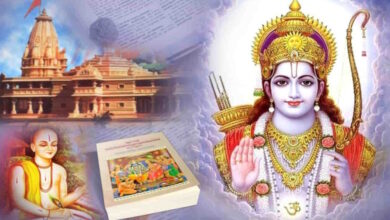Sunderkand by Goswami Tulsidas – Complete Book Summary
📖 Sunderkand by Goswami Tulsidas – Complete Summary for Indian Readers
 Sunderkand is the fifth chapter of the epic Ramcharitmanas composed by the revered saint and poet Goswami Tulsidas in the 16th century. While the Ramcharitmanas retells the story of Lord Rama in Awadhi, Sunderkand specifically focuses on the heroic deeds of Hanuman in Lanka. The word “Sunderkand” itself means “the beautiful episode”, and it rightly justifies the title due to the power-packed, inspiring, and spiritually uplifting events it covers.
Sunderkand is the fifth chapter of the epic Ramcharitmanas composed by the revered saint and poet Goswami Tulsidas in the 16th century. While the Ramcharitmanas retells the story of Lord Rama in Awadhi, Sunderkand specifically focuses on the heroic deeds of Hanuman in Lanka. The word “Sunderkand” itself means “the beautiful episode”, and it rightly justifies the title due to the power-packed, inspiring, and spiritually uplifting events it covers.
In the Indian devotional tradition, Sunderkand holds a special place. It is often recited in homes during difficult times, in temples, and during festivals like Hanuman Jayanti and Navratri, as it is believed to dispel negativity, bring peace, and invoke divine blessings.
🌟 Significance of Sunderkand in Ramcharitmanas
-
Focuses entirely on Hanuman’s unparalleled courage, devotion, and strength.
-
Acts as a turning point in the Ramayana, showing hope even in adversity.
-
Embodies themes of bhakti (devotion), dharma (duty), and divine grace.
-
Brings out the inner beauty of Hanuman’s character – hence, “Sunder-kand”.
🔍 Summary of Sunderkand – Chapter by Chapter
1. Preparation for the Mission
After Lord Rama, accompanied by his brother Lakshmana and the Vanar Sena, reaches the southern seashore in search of Sita, Jambavan then reminds Hanuman of his immense powers. He tells Hanuman that only he is capable of crossing the vast ocean and finding Sita in Lanka.
Hanuman, upon hearing this, grows in size and strength. Tulsidas beautifully describes this moment as Hanuman realizing his true potential, a moment that becomes symbolic for all of us to realize the power within ourselves.
Message: We all have divine potential. Realizing it is the key.
2. The Magnificent Leap Across the Ocean
Hanuman then takes a giant leap from Mount Mahendra — a poetic and symbolic moment that illustrates how faith, devotion, and courage can overcome all obstacles.
During the flight:
-
He defeats the demoness Surasa by outwitting her.
-
He kills another demoness, Simhika, who tries to swallow his shadow.
-
He finally reaches Lanka after overcoming every challenge mid-air.
Symbolism:
-
Surasa = Ego.
-
Simhika = Temptation or distraction.
-
Ocean = Life’s difficulties.
Message: Obstacles are inevitable, but faith and focus will lead you through.
3. Entry into Lanka and Meeting Lankini
Upon entering Lanka, Hanuman is stopped by a guardian demoness named Lankini, who symbolizes the arrogance and ego of the city. Hanuman defeats her, and she realizes that the destruction of Lanka is near, fulfilling a prophecy.
Hanuman roams around the golden city of Lanka, stunned by its beauty and richness, but with his eyes only set on finding Sita.
Message: Even in the midst of temptation, stay true to your mission.
4. Finding Sita in Ashok Vatika
After searching for a long time, Hanuman finds Sita sitting under a tree in Ashok Vatika. She is grief-stricken, pale, and thin, yet her mind remains firm and devoted to Rama.
Hanuman hides in the tree and observes her. Later, he gently approaches her and introduces himself as Rama’s messenger, offering her Rama’s ring as proof.
Sita is overwhelmed with joy and relief. She blesses Hanuman and asks him to convey her message to Rama, requesting him to come soon.
Message: True devotion never fades, even in extreme pain.
5. Hanuman’s Encounter with Ravana
Before leaving Lanka, Hanuman decides to meet Ravana and give him a warning. He destroys Ashok Vatika, defeats many demons including Akshayakumara (Ravana’s son), and allows himself to be captured intentionally.
When taken to Ravana’s court, Hanuman tries to reason with him, advising him to return Sita to avoid destruction. Ravana, filled with pride, mocks him.
As punishment, Ravana orders Hanuman’s tail to be set on fire. But Hanuman, with his divine powers, sets the whole Lanka ablaze with his burning tail, except the area where Sita resides.
Message: Sometimes, you have to take bold actions for the greater good.
6. Return to Lord Rama
After completing his mission successfully, Hanuman shrinks to his normal size and leaps back across the ocean. He returns to Rama and delivers the joyful news about Sita’s wellbeing.
This scene is filled with immense emotional beauty. Rama is overwhelmed and embraces Hanuman with love and respect. Rama declares that even a thousand lifetimes wouldn’t be enough to repay Hanuman for his selfless service.
Message: Loyalty, courage, and devotion will always be rewarded.
🙏 Moral and Spiritual Lessons from Sunderkand
-
Unshakable Faith: Hanuman’s deep faith in Lord Rama empowers him to do the impossible.
-
Self-Realization: Like Hanuman, we must realize the strength and divine energy within us.
-
True Devotion: Hanuman’s unwavering bhakti becomes a guiding light for all devotees.
-
Courage in Adversity: Face challenges head-on without fear.
-
Humility with Strength: Even with immense powers, Hanuman remains humble.
✨ Key Characters in Sunderkand
-
Hanuman: Central hero. Embodiment of strength, service, and devotion.
-
Sita: Symbol of purity, patience, and unwavering love.
-
Ravana: Represents ego and arrogance.
-
Jambavan: Wise elder who reminds Hanuman of his capabilities.
-
Lankini: The gatekeeper of Lanka initially resists, but later accepts Hanuman’s divinity.
🕉️ Why Every Indian Should Read or Listen to Sunderkand
-
It is emotionally uplifting, especially in tough times.
-
Reciting or listening to it is said to bring peace, health, and protection.
-
It promotes moral values, inner strength, and spiritual connection.
-
It’s a timeless text that transcends religion and speaks of universal virtues.
🎶 Musical and Cultural Importance
In many Indian households, Sunderkand Path is a regular ritual. Devotees often perform it collectively in temples or community halls, especially on Tuesdays and Saturdays, which they consider auspicious for Hanuman worship Several versions of Sunderkand exist in music, audiobooks, and TV serials, making it accessible to every generation.
📌 Summary in Simple Points
-
Lord Rama chooses Hanuman to go to Lanka to find Sita.
-
He realizes his powers and leaps across the ocean.
-
Along the way, he faces and defeats several demons.
-
Finds Sita in Ashok Vatika and gives her Rama’s ring.
-
Destroys Ashok Vatika and warns Ravana.
-
Sets Lanka on fire with his burning tail.
-
Returns to Rama with news of Sita’s safety.
🙋♀️ Frequently Asked Questions (FAQs)
Q1: What is the best time to read or listen to Sunderkand?
A: Early morning or evening hours are ideal. Devotees consider Tuesdays and Saturdays the most auspicious days.
Q2: What is the core message of Sunderkand?
A: The power of devotion, courage in adversity, and self-realization through faith.
Q3: Is Sunderkand only for Hindus?
A: Moreover, its messages are universal – about duty, love, courage, and truth – and have the power to inspire anyone.
Q4: How long does it take to read Sunderkand?
A: A full recitation takes about 45 minutes to 1 hour depending on the version.
Q5: Can children read or listen to Sunderkand?
A: Absolutely. It can help instill moral values and introduce them to Indian cultural heritage.
Q5: Where to Buy Sunderkand?
A: You can buy it from Amazon Flipkart or given shop link at the end of the post.


